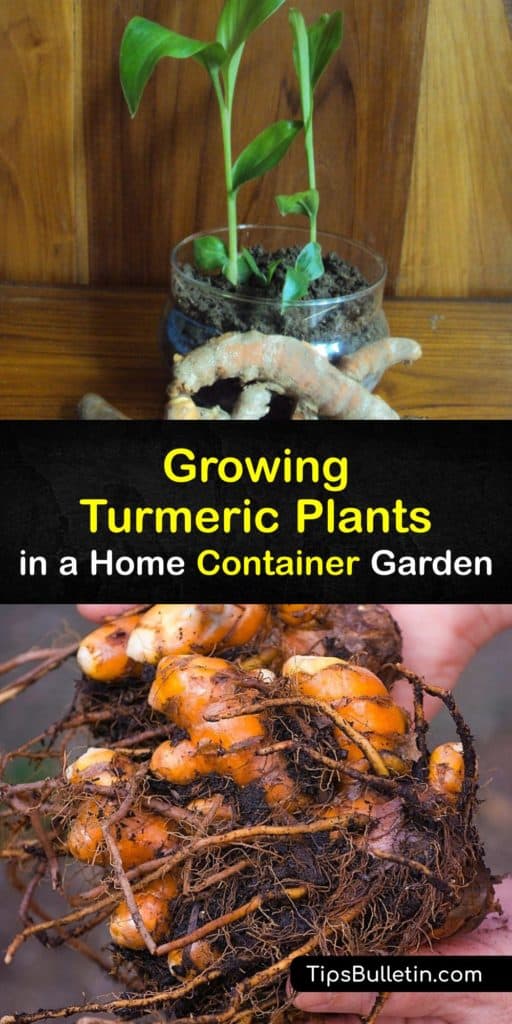Turmeric or Indian saffron is a spice popular in Asian cooking, and it looks similar to ginger root. While it’s easy to find at your local food stores, it comes from the roots of an exotic-looking plant that is simple to grow at home. Learn how to plant turmeric in pots with the right growing conditions and care, and use your turmeric rhizomes for creating spices and growing new plants.
The turmeric plant (Curcuma longa) is a tropical plant that looks stunning in the home, and curry chicken is not complete without this spice. While it is the main ingredient in curry powder, the turmeric plant is also an attractive houseplant that grows three feet tall or more with large green leaves and occasional pink flowers.
As if the appearance of this plant isn’t enough, it also has many health benefits, and growing your own turmeric is a great way to reap the rewards of organic, fresh turmeric spice. Here, we will also show the difference between turmeric and curcumin. The curcumin in the rhizomes is responsible for the spice’s bright color and its antioxidant and anti-inflammatory properties, and it’s popular in Ayurvedic practices.

Container Gardening with Turmeric Plants
There is more reason than one to grow turmeric. The plants add beauty to your home as they mature, and growing turmeric in pots is an excellent way to harvest fresh rhizomes for adding spice to your favorite soups, dressings, and curry dishes.
While Indian saffron is reasonably simple to grow, it needs the right amount of sunshine and some TLC to promote healthy growth. Learn what these plants need to flourish and how to grow them in pots. Harvesting turmeric roots for cooking after growing turmeric in containers is satisfying and yields a great flavor option for your cooked dishes.

Things to Know before Growing Turmeric in Containers
While growing turmeric in containers is relatively straightforward, there are a few things to know about the growing conditions these plants want to thrive. Discover the sun, temperature, humidity requirements, and soil type to ensure your plant stays healthy.
This member of the ginger family (Zingiberaceae) loves warm, humid conditions in partial sun with periods of full sun, and it thrives in neutral, well drained soil. If you live in USDA hardiness zones 8 through 11, it’s safe to grow outdoors in a pot or garden bed.
However, if you live in a cool region, the best way to plant turmeric is to start indoors in late winter and then move it outside in the summer. It takes roughly seven to ten months to grow from sprouting to harvest, so count back ten months from your first fall frost to determine when to start growing your tumeric plant.
How to Plant Turmeric in Pots
It’s easy to regrow turmeric (Curcuma longa) from rhizomes, but it’s best to get ginger or turmeric from your local nursery rather than use the ones from the grocery store since those are usually treated with a growth inhibitor.
What about ginseng? Is ginger and ginseng the same? Ginger, ginseng, and turmeric are all different plants, though they require similar growing strategies. Here is how to regrow turmeric from the root sections.
Whether you are growing turmeric or planting ginger in a pot, start by cutting the rhizome into sections, ensuring each part has two to three buds. Fill three-inch pots with potting mix and organic matter, and lay a rhizome flat on the dirt. Cover with soil, water well, and slip the planters into a clear plastic bag.
Set them in the warmest area to encourage faster germination and check on them daily. Once the turmeric begins sprouting, move them to a sunny windowsill or beneath grow lights and remove the plastic covers.
Once the plants get six to eight inches tall, transplant them to a larger pot and move them outdoors in the early spring once the danger of frost passes. Fertilize them with organic fertilizer or liquid fertilizer every few weeks.
Making Spices after Growing Turmeric in Pots
Seven to ten months after growing turmeric in pots, the turmeric leaves and stems begin to turn brown and dry, and it’s time to gather the rhizomes. This is also the best time to harvest ginger. Learn how to harvest the fresh turmeric, turn it into a spice, and save it for growing new plants.
To harvest the rhizomes during dormancy, tip the plants out of the soil, cut the stems off an inch above the turmeric root, and wash the rhizomes well. Similar to ginger shelf life, store turmeric in the fridge in an airtight container for up to six months, or make homemade Indian saffron spice.
Place the turmeric rhizomes in a pot of boiling water and simmer until they are easy to pierce with a fork. Don’t forget to set one or two of the largest rhizomes aside for replanting.
Drain, rub off the skins with your fingers and dry them in a dehydrator at 140°F until they are brittle and snap cleanly. Grind the rhizomes in a coffee grinder and store them in a spice jar.
While we often think of turmeric as an exotic spice from the grocery store, growing your own Indian saffron plant at home is straightforward and rewarding. The plant adds appeal to the environment, and the roots flavor your favorite dishes at the end of the growing season.

Knowing how to plant turmeric in pots keeps your home filled with beautiful houseplants and your pantry stocked with spices, so why not share our turmeric container garden guide with the plant-lovers in your life on Pinterest and Facebook?